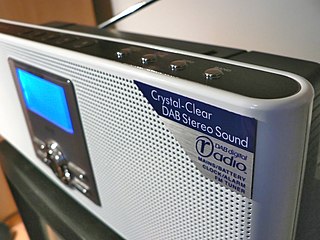 W
WAstra Digital Radio (ADR) was a system used by SES for digital radio transmissions on the early Astra satellites, using the audio subcarrier frequencies of analogue television channels. It was introduced in 1995. As of February 2008, there were still 51 stations transmitting in this format. ADR ceased on 30 April 2012 when analogue broadcasts on Astra 19.2°E ended.
 W
WIn telecommunications, the (digital) cliff effect or brickwall effect is a sudden loss of digital signal reception. Unlike analog signals, which gradually fade when signal strength decreases or electromagnetic interference or multipath increases, a digital signal provides data which is either perfect or non-existent at the receiving end. It is named for a graph of reception quality versus signal quality, where the digital signal "falls off a cliff" instead of having a gradual rolloff. This is an example of an EXIT chart.
 W
WDigital Audio Broadcasting (DAB) is a digital radio standard for broadcasting digital audio radio services in many countries around the world, defined and promoted by the WorldDAB forum. The standard is dominant in Europe and is also used in parts of Africa, Asia and Australia; other worldwide terrestrial digital radio standards include HD Radio, ISDB-Tb, DRM, and the related DMB.
 W
WIn the United Kingdom, the roll-out of digital radio has been proceeding since engineering test transmissions were started by the BBC in 1990 followed by a public launch in September 1995. The UK currently has one of the world's biggest digital radio networks, with about 500 transmitters, three national DAB ensembles and 48 local and regional DAB ensembles broadcasting over 250 commercial and 34 BBC radio stations across the UK. In London there are already more than 100 different digital stations available. In addition to DAB and DAB+, radio stations are also broadcast on digital television platform as well as internet radio in the UK. Digital radio ensemble operators and stations need a broadcasting licence from the UK's media regulator Ofcom to broadcast.
 W
WDigital Radio Mondiale is a set of digital audio broadcasting technologies designed to work over the bands currently used for analogue radio broadcasting including AM broadcasting, particularly shortwave, and FM broadcasting. DRM is more spectrally efficient than AM and FM, allowing more stations, at higher quality, into a given amount of bandwidth, using xHE-AAC audio coding format. Various other MPEG-4 and Opus codecs are also compatible, but the standard now specifies xHE-AAC.
 W
WHD Radio (HDR) is a trademarked term for the in-band on-channel (IBOC) digital radio technology. It is generally used to simulcast an existing analog radio station in digital format with less noise and with additional text information. HD Radio is used primarily by AM and FM radio stations in the United States, Canada, and Mexico, with a few implementations outside North America.
 W
WIn telecommunications and computer networks, multiplexing is a method by which multiple analog or digital signals are combined into one signal over a shared medium. The aim is to share a scarce resource. For example, in telecommunications, several telephone calls may be carried using one wire. Multiplexing originated in telegraphy in the 1870s, and is now widely applied in communications. In telephony, George Owen Squier is credited with the development of telephone carrier multiplexing in 1910.
 W
WThe Psion Wavefinder was a computer peripheral for receiving digital audio broadcasting radio signals, made by Psion. It attached via USB to a personal computer, and had no loudspeakers or controls of its own, with only a flashing light on the device. Psion hoped it would become a design classic.
 W
WSatellite Digital Audio Broadcast Co., Ltd. , trading as St.GIGA , was a Japanese satellite radio company headquartered in Akasaka, Tokyo. The company was established on April 2, 1990 as a subsidiary of the television station provider WOWOW, achieving a cult following through its "Tide of Sound" nature sounds recording broadcasts and its nonstandard methodology. By 1994, St.GIGA was struggling financially due to the Japanese Recession affecting the demand for its ambient music, as consumers became reluctant to invest in satellite tuners.